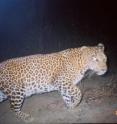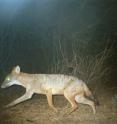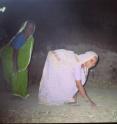Look out squirrels: Leopards are new backyard wildlife
A new study led by WCS-India scientist Vidya Athreaya finds that certain landscapes of western India completely devoid of wilderness and with high human populations are crawling with a different kind of backyard wildlife: leopards. The study found as many as five adult large carnivores, including leopards and striped hyenas, per 100 square kilometers (38 square miles), a density never before reported in a human-dominated landscape.
The study, called "Big Cats in Our Backyards," appeared in the March 6 edition of the journal PLoS One. Authors include: Vidya Athreya and Ullas Karanth of the Wildlife Conservation Society and Centre for Wildlife Studies in Bangalore; Morten Odden of Hedmark University College; John D. C. Linnell of the Norwegian Institute for Nature Research; and Jagdish Krishnaswamy of Asoka Trust for Research of Ecology in the Environment.
Using camera traps, the authors founds that leopards often ranged close to houses at night though remained largely undetected by the public. Despite this close proximity between leopards and people, there are few instances of attacks in this region. The authors also photographed rusty spotted cat, small Indian civet, Indian fox, jungle cat, jackal, mongoose -- and a variety of people from the local communities. The research took place in western Maharashtra, India.
"Human attacks by leopards were rare despite a potentially volatile situation considering that the leopard has been involved in serious conflict, including human deaths in adjoining areas," said big cat expert Ullas Karanth of WCS. "The results of our work push the frontiers of our understanding of the adaptability of both humans and wildlife to each other's presence."
The authors say that the findings show that conservationists must look outside of protected areas for a more holistic approach to safeguarding wildlife in a variety of landscapes.
Source: Wildlife Conservation Society
Other sources
- Leopards and humans peacefully coexist in Indiafrom MSNBC: ScienceSun, 31 Mar 2013, 17:30:37 UTC
- Move over squirrels: Leopards are new backyard wildlifefrom Science DailySat, 30 Mar 2013, 19:30:45 UTC
- Leopards and Humans Peacefully Coexist in Indiafrom Live ScienceFri, 29 Mar 2013, 22:30:27 UTC
- Backyard Leopards Caught on Camerafrom Live ScienceFri, 29 Mar 2013, 17:30:23 UTC
- India leopards show no fear of humansfrom UPIFri, 29 Mar 2013, 0:00:29 UTC
- Look Out Squirrels: Leopards are New Backyard Wildlifefrom Newswise - ScinewsThu, 28 Mar 2013, 17:00:18 UTC
- Look out squirrels: Leopards are new backyard wildlifefrom PhysorgThu, 28 Mar 2013, 16:30:48 UTC


